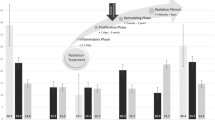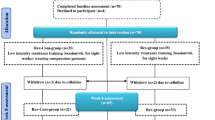Abstract
The aim of this study was to determine whether an exercise program, commencing 4–6 weeks post-operatively, reduces upper limb impairments in women treated for early breast cancer. Women (n = 160) were randomized to either an 8-week exercise program (n = 81) or to a control group (n = 79) following stratification for axillary surgery. The exercise program comprised a weekly session and home program of passive stretching and progressive resistance training for shoulder muscles. The control group attended fortnightly assessments but no exercises were provided. The primary outcome was self-reported arm symptoms derived from the EORTC breast cancer-specific questionnaire (BR23), scored out of 100 with a low score indicative of fewer symptoms. The secondary outcomes included physical measures of shoulder range of motion, strength, and swelling (i.e., lymphedema). Women were assessed immediately following the intervention and at 6 months post-intervention. The change in symptoms from baseline was not significantly different between groups immediately following the intervention or at 6 m post-intervention. The between group difference immediately following the intervention was 4 (95% CI −1 to 9) and 6 months post-intervention was 4 (−2 to 10). However, the change in range of motion for flexion and abduction was significantly greater in the exercise group immediately following the intervention, as was change in shoulder abductor strength. In conclusion, a supervised exercise program provided some, albeit small, additional benefit at 6 months post-intervention to women who had been provided with written information and reminders to use their arm. Both the groups reported few impairments including swelling immediately following the intervention and 6 months post-intervention. Notably, resistance training in the post-operative period did not precipitate lymphedema.



Similar content being viewed by others
References
McNeely ML, Campbell K, Ospina M, Rowe BH, Dabbs K, Klassen TP, Mackey J, Courneya K (2010) Exercise interventions for upper-limb dysfunction due to breast cancer treatment. Cochrane Database Syst Rev CD005211
McNeely M (2006) Exercise Interventions for upper limb dysfunction due to breast cancer surgery. Cochrane Database Syst Rev 1
Sagen A, Karesen R, Sandvik L, Risberg MA (2009) Changes in arm morbidities and health-related quality of life after breast cancer surgery—a five-year follow-up study. Acta Oncol 48:1111–1118
Ashikaga T, Krag DN, Land SR, Julian TB, Anderson SJ, Brown AM, Skelly JM, Harlow SP, Weaver DL, Mamounas EP et al (2010) Morbidity results from the NSABP B-32 trial comparing sentinel lymph node dissection versus axillary dissection. J Surg Oncol 102:111–118
Nesvold IL, Fossa SD, Holm I, Naume B, Dahl AA (2010) Arm/shoulder problems in breast cancer survivors are associated with reduced health and poorer physical quality of life. Acta Oncol 49:347–353
Kaya T, Karatepe AG, Gunaydn R, Yetis H, Uslu A (2010) Disability and health-related quality of life after breast cancer surgery: relation to impairments. South Med J 103:37–41
Mutrie N, Campbell AM, Whyte F, McConnachie A, Emslie C, Lee L, Kearney N, Walker A, Ritchie D (2007) Benefits of supervised group exercise programme for women being treated for early stage breast cancer: pragmatic randomised controlled trial. BMJ 334:517
Cho OH, Yoo YS, Kim NC (2006) Efficacy of comprehensive group rehabilitation for women with early breast cancer in South Korea. Nurs Health Sci 8:140–146
Courneya KS, Segal RJ, Mackey JR, Gelmon K, Reid RD, Friedenreich CM, Ladha AB, Proulx C, Vallance JK, Lane K et al (2007) Effects of aerobic and resistance exercise in breast cancer patients receiving adjuvant chemotherapy: a multicenter randomized controlled trial. J Clin Oncol 25:4396–4404
Torres Lacomba M, Yuste Sanchez MJ, Zapico Goni A, Prieto Merino D, Mayoral del Moral O, Cerezo Tellez E, Minayo Mogollon E (2010) Effectiveness of early physiotherapy to prevent lymphoedema after surgery for breast cancer: randomised, single blinded, clinical trial. BMJ 340:b5396
Chan DN, Lui LY, So WK (2010) Effectiveness of exercise programmes on shoulder mobility and lymphoedema after axillary lymph node dissection for breast cancer: systematic review. J Adv Nurs 66:1902–1914
Johansson K, Ingvar C, Albertsson M, Ekdahl C (2001) Arm lymphoedema, shoulder mobility and muscle strength after breast cancer treatment—a prospective 2-year study. Adv Physiother 3:55–66
Nikkanen TA, Vanharanta H, Helenius-Reunanen H (1978) Swelling of the upper extremity, function and muscle strength of shoulder joint following mastectomy combined with radiotherapy. Ann Clin Res 10:273–279
Brennan MJ (1992) Lymphedema following the surgical treatment of breast cancer: a review of pathophysiology and treatment. J Pain Symptom Manage 7:110–116
Mortimer PS (1995) Managing lymphedema. Clin Exp Dermatol 20:98–106
Schmitz KH, Ahmed RL, Troxel A, Cheville A, Smith R, Lewis-Grant L, Bryan CJ, Williams-Smith CT, Greene QP (2009) Weight lifting in women with breast-cancer-related lymphedema. N Engl J Med 361:664–673
Schmitz KH, Ahmed RL, Troxel AB, Cheville A, Lewis-Grant L, Smith R, Bryan CJ, Williams-Smith CT, Chittams J (2010) Weight lifting for women at risk for breast cancer-related lymphedema: a randomized trial. JAMA 304:2699–2705
Kilbreath SL, Refshauge KM, Beith JM, Ward LC, Simpson JM, Hansen RD (2006) Progressive resistance training and stretching following surgery for breast cancer: study protocol for a randomised controlled trial. BMC Cancer 6:273
Borg GA (1982) Psychophysical bases of perceived exertion. Med Sci Sports Exerc 14:377–381
Aaronson NK, Ahmedzai S, Bergman B, Bullinger M, Cull A, Duez NJ, Filiberti A, Flechtner H, Fleishman SB, de Haes JC et al (1993) The European Organization for Research and Treatment of Cancer QLQ-C30: a quality-of-life instrument for use in international clinical trials in oncology. J Natl Cancer Inst 85:365–376
Hjermstad MJ, Fossa SD, Bjordal K, Kaasa S (1995) Test/retest study of the European Organization for Research and Treatment of Cancer Core Quality-of-Life Questionnaire. J Clin Oncol 13:1249–1254
Sprangers MA, Groenvold M, Arraras JI, Franklin J, te Velde A, Muller M, Franzini L, Williams A, de Haes HC, Hopwood P et al (1996) The European Organization for Research and Treatment of Cancer breast cancer-specific quality-of-life questionnaire module: first results from a three-country field study. J Clin Oncol 14:2756–2768
Cornish BH, Bunce IH, Ward LC, Jones LC, Thomas BJ (1996) Bioelectrical impedance for monitoring the efficacy of lymphoedema treatment programmes. Breast Cancer Res Treat 38:169–176
Czerniec SA, Ward LC, Refshauge KM, Beith J, Lee MJ, York S, Kilbreath SL (2010) Assessment of breast cancer-related arm lymphedema—comparison of physical measurement methods and self-report. Cancer Invest 28:54–62
Ward LC, Dylke E, Czerniec S, Isenring E, Kilbreath SL (2011) Confirmation of the reference impedance ratios used for assessment of breast cancer-related lymphedema by bioelectrical impedance spectroscopy. Lymphat Res Biol 9:47–51
Ward LC, Kilbreath S, Cornish BH (2008) Bioimpedance analysis for early detection of lymphedema. In: Weissieder H, Schuchhardt C (eds) Lymphedema: diagnosis and therapy, 4th edn. Viavital, Essen, pp 502–517
Cornish BH, Chapman M, Thomas BJ, Ward LC, Bunce IH, Hirst C (2000) Early diagnosis of lymphedema in postsurgery breast cancer patients. Ann N Y Acad Sci 904:571–575
Gjorup C, Zerahn B, Hendel HW (2010) Assessment of volume measurement of breast cancer-related lymphedema by three methods: circumference measurement, water displacement, and dual energy X-ray absorptiometry. Lymphat Res Biol 8:111–119
Kilbreath S, Refshauge K, Beith J, Lee M (2006) Resistance and stretching shoulder exercises early following axillary surgery for breast cancer. Rehabil Oncol 24:9–14
Beurskens CH, van Uden CJ, Strobbe LJ, Oostendorp RA, Wobbes T (2007) The efficacy of physiotherapy upon shoulder function following axillary dissection in breast cancer, a randomized controlled study. BMC Cancer 7:166
Wingate L, Croghan I, Natarajan N, Michalek AM, Jordan C (1989) Rehabilitation of the mastectomy patient: a randomized, blind, prospective study. Arch Phys Med Rehabil 70:21–24
Lee TS, Kilbreath SL, Refshauge KM, Herbert RD, Beith JM (2008) Prognosis of the upper limb following surgery and radiation for breast cancer. Breast Cancer Res Treat 110:19–37
Lee TS, Kilbreath SL, Refshauge KM, Pendlebury SC, Beith JM, Lee MJ (2007) Pectoral stretching program for women undergoing radiotherapy for breast cancer. Breast Cancer Res Treat 102:313–321
Cinar N, Seckin U, Keskin D, Bodur H, Bozkurt B, Cengiz O (2008) The effectiveness of early rehabilitation in patients with modified radical mastectomy. Cancer Nurs 31:160–165
Shamley DR, Srinanaganathan R, Weatherall R, Oskrochi R, Watson M, Ostlere S, Sugden E, Shamley DR, Srinanaganathan R, Weatherall R et al (2007) Changes in shoulder muscle size and activity following treatment for breast cancer. Breast Cancer Res Treat 106:19–27
Shamley D, Srinaganathan R, Oskrochi R, Lascurain-Aguirrebena I, Sugden E (2009) Three-dimensional scapulothoracic motion following treatment for breast cancer. Breast Cancer Res Treat 118:315–322
Crosbie J, Kilbreath SL, Dylke E, Refshauge KM, Nicholson LL, Beith JM, Spillane AJ, White K (2010) Effects of mastectomy on shoulder and spinal kinematics during bilateral upper-limb movement. Phys Ther 90:679–692
de Rezende LF, Franco RL, de Rezende MF, Beletti PO, Morais SS, Gurgel MS, de Rezende LF, Franco RL, de Rezende MF, Beletti PO et al (2006) Two exercise schemes in postoperative breast cancer: comparison of effects on shoulder movement and lymphatic disturbance. Tumori 92:55–61
Schmitz KH, Troxel AB, Cheville A, Grant LL, Bryan CJ, Gross CR, Lytle LA, Ahmed RL (2009) Physical activity and lymphedema (the PAL trial): assessing the safety of progressive strength training in breast cancer survivors. Contemp Clin Trials 30:233–245
Cavanaugh KM (2011) Effects of early exercise on the development of lymphedema in patients with breast cancer treated with axillary lymph node dissection. J Oncol Pract 7:89–93
Cheema B, Gaul CA, Lane K, Singh MAF (2008) Progressive resistance training in breast cancer: a systematic review of clinical trials. Breast Cancer Res Treat 109:9–26
McNeely ML, Peddle CJ, Yurick JL, Dayes IS, Mackey JR (2011) Conservative and dietary interventions for cancer-related lymphedema: a systematic review and meta-analysis. Cancer 117:1136–1148
Shamley DR, Barker K, Simonite V, Beardshaw A (2005) Delayed versus immediate exercises following surgery for breast cancer: a systematic review. Breast Cancer Res Treat 90:263–271
Acknowledgments
This project was supported by the NSW Cancer Council. SLK’s research fellowship is funded by the National Breast Cancer Foundation.
Disclosures
SLK has received research funding from Impedimed; LCW consults to Impedimed and has received grant funding from Impedimed.
Conflict of interest
None.
Author information
Authors and Affiliations
Corresponding author
Rights and permissions
About this article
Cite this article
Kilbreath, S.L., Refshauge, K.M., Beith, J.M. et al. Upper limb progressive resistance training and stretching exercises following surgery for early breast cancer: a randomized controlled trial. Breast Cancer Res Treat 133, 667–676 (2012). https://doi.org/10.1007/s10549-012-1964-1
Received:
Accepted:
Published:
Issue Date:
DOI: https://doi.org/10.1007/s10549-012-1964-1




